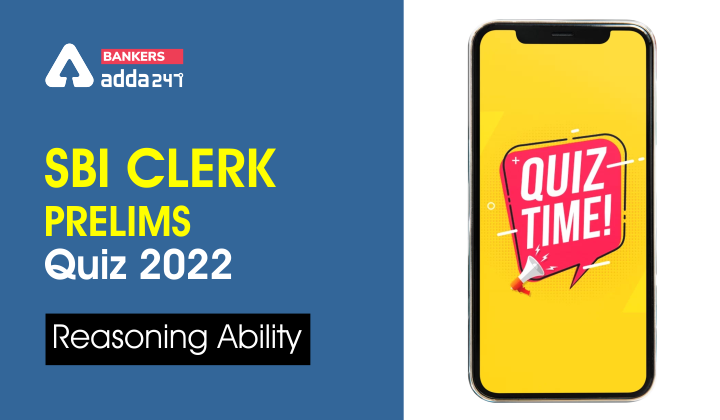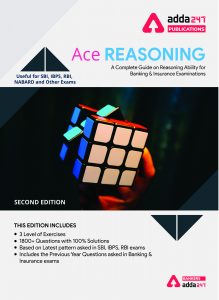Directions (1–5): In each of the question, relationships between some elements are shown in the statements(s). These statements are followed by conclusions numbered I and II. Read the statements and give the answer.
Q1. Statements: E ≤ R >T, G > R, K < R
Conclusions: I. K > T II. G > T
(a) If only conclusion I follows.
(b) If only conclusion II follows.
(c) If either conclusion I or II follows.
(d) If neither conclusion I nor II follows.
(e) If both conclusions I and II follow.
Q2. Statements: V >B >M > G > L < I ≤ J
Conclusions: I. V > J II. I ≥ B
(a) If only conclusion I follows.
(b) If only conclusion II follows.
(c) If either conclusion I or II follows.
(d) If neither conclusion I nor II follows.
(e) If both conclusions I and II follow.
Q3. Statements: O < M < Y > D, W<Y
Conclusions: I. Y> O II. W>O
(a) If only conclusion I follows.
(b) If only conclusion II follows.
(c) If either conclusion I or II follows.
(d) If neither conclusion I nor II follows.
(e) If both conclusions I and II follow.
Q4. Statements: I ≥ J> R > E < L, X < L, E > Y
Conclusions: I. I >E II. J>Y
(a) If only conclusion I follows.
(b) If only conclusion II follows.
(c) If either conclusion I or II follows.
(d) If neither conclusion I nor II follows.
(e) If both conclusions I and II follow.
Q5. Statements: P < W < Y ≥ I > V, Y > X
Conclusions: I. W < V II. Y> P
(a) If only conclusion I follows.
(b) If only conclusion II follows.
(c) If either conclusion I or II follows.
(d) If neither conclusion I nor II follows.
(e) If both conclusions I and II follow.
Directions (6-10): In these questions, relationship between different elements is shown in the statements. These statements are followed by two conclusions.
Q6. Statement: Z≥O≥N=E>K, J>R=S≤N
Conclusion: I. N≥J II. J>E
(a) If only conclusion II follows.
(b) If only conclusion I follows.
(c) If both conclusion I and conclusion II follow
(d) If neither conclusion I nor conclusion II follows.
(e) If either conclusion I or conclusion II follows.
Q7. Statement: F≥R>I>E≤N, E=D≥T
Conclusion: I. F≥T II. R>T
(a) If neither conclusion I nor conclusion II follows.
(b) If only conclusion I follows.
(c) If both conclusion I and conclusion II follow
(d) If only conclusion II follows.
(e) If either conclusion I or conclusion II follows.
Q8. Statement: A<B≤C=D, E≥C≤F≤G
Conclusion: I. E>A II. G>A
(a) If only conclusion II follows.
(b) If either conclusion I or conclusion II follows.
(c) If both conclusion I and conclusion II follow
(d) If neither conclusion I nor conclusion II follows.
(e) If only conclusion I follows.
Q9. Statement: F≥R≤I>E≤N, E=D≥T
Conclusion: I. T>N II. N≥T
(a) If neither conclusion I nor conclusion II follows.
(b) If only conclusion I follows.
(c) If both conclusion I and conclusion II follow
(d) If only conclusion II follows.
(e) If either conclusion I or conclusion II follows.
Q10. Statement: A<B≤C=D, E≥C≤F≤G
Conclusion: I. G>A II. D>G
(a) If only conclusion I follows.
(b) If only conclusion II follows.
(c) If both conclusion I and conclusion II follow
(d) If neither conclusion I nor conclusion II follows.
(e) If either conclusion I or conclusion II follows.
Directions (11-15): In these questions, a relationship between different elements is shown in the statements. The statements are followed by two conclusions. Give answer
Q11. Statement: L≥B≥K, L≤T≤I, W<P≤L, I≥M<X
Conclusion: I. K<X II. W>M
(a) if only conclusion II is true.
(b) if only conclusion I is true.
(c) if neither conclusion I nor II is true.
(d) if either conclusion I or II is true.
(e) if both conclusions I and II are true.
Q12. Statement: D≤A≤M<S, Z<U≤D, Q>A≤Y<G
Conclusion: I. Z<Y II. S>Q
(a) if both conclusion I and II are true.
(b) if only conclusion I is true.
(c) if neither conclusion I nor II is true.
(d) if either conclusion I or II is true.
(e) if only conclusion II is true.
Q13. Statement: L≤T, W<P≤L≥B≥K, T≤I≥M<X
Conclusion: I. K≥M II. P>M
(a) if only conclusion II is true.
(b) if either conclusion I or II is true.
(c) if neither conclusion I nor II is true.
(d) if only conclusion I is true.
(e) if both conclusions I and II are true.
Q14. Statement: D≤A≤M<S, Z<U≤D, Q>A≤Y<G
Conclusion: I. M≥U II. G>Z
(a) if only conclusion II is true.
(b) if only conclusion I is true.
(c) if neither conclusion I nor II is true.
(d) if either conclusion I or II is true.
(e) if both conclusions I and II are true.
Q15. Statement: B≤T<F≤R, J>K≥H, H=U≥B,
Conclusion: I. J>B II. H<R
(a) if only conclusion II is true.
(b) if either conclusion I or II is true.
(c) if neither conclusion I nor II is true.
(d) if only conclusion I is true.
(e) if both conclusions I and II are true.
Solutions
S1. Ans. (b)
S2. Ans. (d)
S3. Ans. (a)
S4. Ans. (e)
S5. Ans. (b)
S6. Ans. (e)
S7. Ans. (d)
S8. Ans. (c)
S9. Ans. (d)
S10. Ans. (a)
S11. Ans. (c)
Sol. I. K<X (false) II. W>M(false)
S12. Ans. (b)
Sol. I. Z<Y (True) II. S>Q (false)
S13. Ans. (c)
Sol. I. K≥M(false) II. P>M(false)
S14. Ans. (e)
Sol. I. M≥U (True) II. G>Z(True)
S15. Ans. (d)
Sol. I. J>B(True) II. H<R(false)





 GA Capsule for SBI Clerk Mains 2025, Dow...
GA Capsule for SBI Clerk Mains 2025, Dow...
 The Hindu Review October 2022: Download ...
The Hindu Review October 2022: Download ...
 IB ACIO 2025 Notification PDF Out for 37...
IB ACIO 2025 Notification PDF Out for 37...


